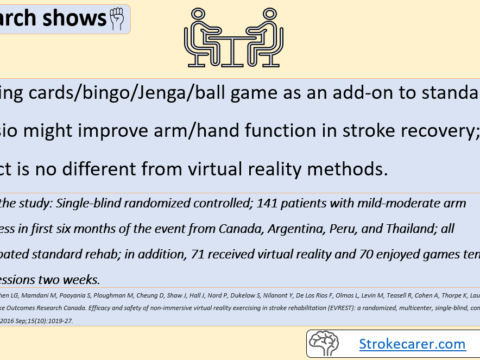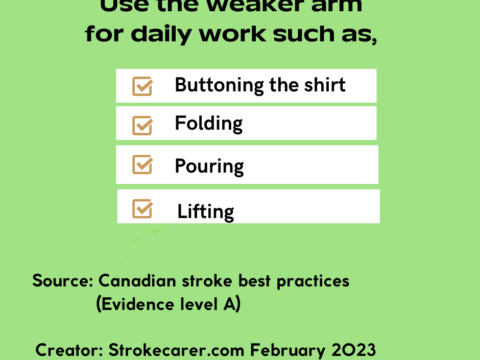
- Start an intense exercise program
- Do activities that are meaningful, engaging, and task-specific
- Repeat the chosen activities incrementally and consistently
- Add aerobic and muscle-strengthening exercises
- Set goals
Start an intense activity/ exercise program
Make every effort to create an intense and regular exercise program for at least three months. Research reveals it does not happen even in high-income countries with resource limitations such as adequately trained staff, lack of regional training centres, difficulty travelling to such centres, time etc.
However, before starting an exercise program a qualified health professional should screen and prescribe suitable exercises.
Choose meaningful and engaging tasks
The exercise program should focus on meaningful and engaging tasks.
These should be the activities of daily living – the activities necessary to become independent in daily tasks.
Let us consider one example: “Sit-to-stand”.
- This is a meaningful and engaging activity.
- It is a task-specific activity that has to stand before walking.
It should also include activities meaningful to the affected such as work-related skills and even a hobby.
There are specific recommendations that apply to regain movements of arms and hands as well as walking ability.
Research reveals that the training benefit may last six months after the training4. The Stroke Rehabilitation Clinician Handbook says such activities help reorganize new neurons and make changes last long5.
Repeat, repeat, and repeat!
How many repetitions?
To date no definite answer exists to this question; however, Janice Eng, a University of British Columbia physiotherapist,6 has attempted to answer this question about regaining arm and hand movements.
More specifically, her research question was as follows;
How many daily repetitions can positively change the brain after a stroke?
Quoting findings from earlier researchers (Nudo et al. 1996; Murata et al. 2007), she writes it would be between 600 – 1000 “successful” reach and grasp repetitions per day. John W. Krakauer and the team write in their 2015 research paper that it should be around 400 repetitions based on the findings from animal studies.
What is a “successful repetition”?
A “successful repetition” refers to an act of reaching and grasping without any droppings. However, one has to keep in mind these findings were from experiments with monkeys after a stroke.
Does this happen even at the best rehab centres?
It is not.
Not even close to it.
In 2009 Lang C. et al.7 found such centres would carry out about 32 repetitions per session (day). Later research8 that analyzed metadata showed the more the better.
And, the 2021 Australian Guidelines9 recommend encouraging the affected to practice outside the scheduled treatment sessions.
Consistency
Consistency is the most important requirement for success but is difficult to adhere to.
Exercise and physical activities become effective,
if done consistently.
Stroke Journal, 20143
Add aerobic and muscle-strengthening exercise
The Heart and Stroke Foundation10 emphasizes four types of exercises to regain movements after a stroke. Those are;
- Endurance (aerobic)
- Strength
- Balance
- Stretching
The American Heart and Stroke Association Statement3 recommends that people with stroke perform aerobic exercises 3-7 days a week and other types – strengthening, flexibility, and neuromuscular 2-3 days a week for life. A sufficient dose or intensity is essential to recover movements after a stroke.
Set goals
The 2021 Australian Guidelines strongly recommend setting goals for each activity together with the affected and their caregivers2. This is one of the most important but neglected ones. It requires tools to monitor progress; if the tools are visual they will act as a motivator also.
One caveat
Please consider the following when you plan to regain movements after a stroke.
- How severe the stroke was at the beginning: It matters a lot; the more severe the damage the lesser the amount of regaining lost movements after a stroke.
- Age: The higher the age the lesser the recovery.
Why the first six months are critical for better recovery?
Read the brain’s recovery attempts after stroke.
Next, read also
- How to recover arm/hand movements after a stroke
- Best practices to recover walking ability after stroke
- Brain’s recovery attempts after stroke
How to motivate stroke carers and stroke survivors
This is the hardest part. Let us see what techniques rehab professionals use to motivate stroke survivors to keep going with their exercise program.
Active listening
Rehabilitation professionals use different strategies to motivate their patients. One of the strategies is active listening, which is a core communication skill in counselling. Research shows that counselling can improve the mood of stroke patients.
Praise
Another strategy is giving praise, which can boost the patient’s motivation and improve their performance. Daily feedback with praise has also been found to be effective in improving walking speed in stroke patients.
The other proven methods include,
- Goal setting,
- providing relevant information,
- Communication training programs for caregivers,
- The presence of family members,
References
- National Institute for Health and Care Excellence (NICE) Guidelines 2019): Stroke and Transient Ischemic Attack in over 16s: Diagnosis and Initial Management, published on May 1, 2019. accessed on May 27, 2021.
- Australian Clinical Guidelines for Stroke Management: Chapter 5 of 8. Rehabilitation. accessed June 5, 2021.
- American Heart Association/American Stroke Association (2014): Physical activity and exercise recommendations for stroke survivors. Stroke Journal, 2014. Accessed on June 6, 2021.
- French B, Thomas LH, Coupe J, McMahon NE, Connell L, Harrison J, Sutton CJ, Tishkovskaya S, Watkins CL.Repetitive task training for improving functional ability after stroke.Cochrane Database of Systematic Reviews2016, Issue 11. Art. No.: CD006073.DOI: 10.1002/14651858.CD006073.pub3.www.cochranelibrary.com repetitive task training for improving functional ability after stroke (Review)Copyright © 2016 The Cochrane Collaboration. Published by John Wiley & Sons, Ltd.
- Teasle R. et al. (2020): Stroke Rehabilitation Clinicians Handbook (2020): Lower extremity Motor and Mobility Rehabilitation. accessed May 27, 2021.
- Janice Eng (2013): Strategies to increase upper and lower extremity physical activity after stroke. CPSR lecture. 2013. Youtube presentation. Accessed on June 6, 2021.
- Lang C. et al. (2009): Observation of amount of movement practice during stroke rehabilitation. Arch Phy Med Rehab. Accessed on June 6, 2021.
- Lohse K.R. et l. (2014): Is more better? Stroke. Accessed on June 6, 2021.
- Australian Clinical Guidelines for Stroke Management (2021): Amount of rehabilitation. Accessed on June 6, 2021.
- Heart and Stroke Foundation: Exercise after stroke. accessed May 25, 2021.
Read more…
- Exercise rehab guidelines and manuals
- Glossary of Terms: physical fitness and related terms
- Blend cardio with muscle-strengthening exercises
Additional resources
Exercises after stroke: An excellent but simple resource guide from the Stroke Foundation, New Zealand
It is rare to find online materials without copyright issues. However, I found an excellent open-access resource published by Margot Andrew, Margaret Hoessly, and Kate Hedges. It is under the Creative Commons Attribution Non-Commercial License (https://creativecommons.org/licenses/by-nc/3.0/), which permits unrestricted non-commercial use, distribution, and reproduction in any medium, provided the original author and source are credited.
Physical activities and exercise, and wellness videos for people with mobility challenges
A team of physiotherapists and occupational therapists from the University Health Network have published a list of exercises and wellness videos for people with mobility challenges. It includes an excellent collection of YouTube video clips. Here are some relevant ones. One should keep in mind that these resources do not replace the exercise regimen prescribed by your healthcare professional.
Three-part series of the “it’s Your Choice” project:
- Part I: An intro and disclaimer: https://www.youtube.com/watch?v=kpTHDR5k-cY
- Part II: The warm-up: https://www.youtube.com/watch?v=XPmUqiTBEpU
- Part III: Strength, balance, and aerobic exercises: https://www.youtube.com/watch?v=Qh94WI9Ecoc



